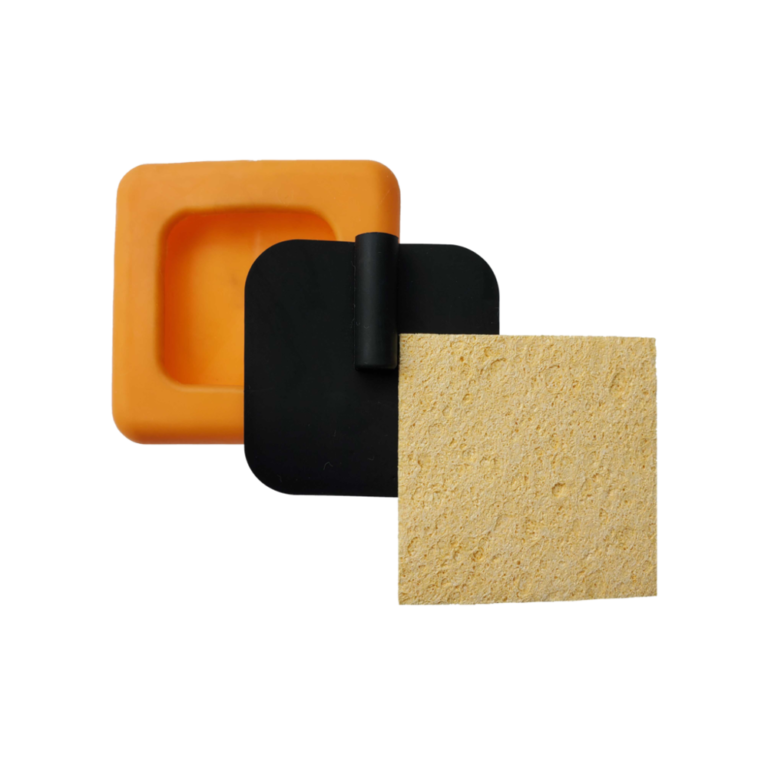In transcranial Direct Current Stimulation and brain stimulation in general the word “electrode” comes up a lot! As in “anode electrode”, or “cathode electrode”, or “the electrode was placed over this brain region”. So what is it?
According to the definitive “Transcranial electrical stimulation nomenclature” published in Brain Stimulation we need to think about “Electrode Assembly” and “Electrode”. A lot of times when we say electrode in tDCS we mean electrode assembly. In fact in tDCS we never say electrode assembly. So below is a rather detailed and precise look at things.
Don’t have the time to read it all now? Here are the takeaways: Electrode design is among the most important things in a good tDCS device. In practice, in tDCS, the electrode refers to the part of the device that is placed on the head and carrier the current from the tDCS device into the head. Any non-conducting material that is bound to the conductive components (like a rubber backing) is also considered part of the electrode. But headgear used to hold the electrode in place and the cables are not considered part of the electrode. And electrode must have a metal or conductive rubber in it. And electrode must also have an electrolyte, which is anything semi-fluid with salt in it. The electrolyte, not the metal or rubber, should touch the skin. In chemistry, the electrode is much more specific and refer to the interface between the metal or conductive rubber and the electrolyte.

FROM “TRANSCRANIAL ELECTRICAL STIMULATION NOMENCLATURE”
The ELECTRODE ASSEMBLY refers to all components that carry current between the connector-end of device lead wire and the scalp such as metal electrode, conductive rubber electrode, electrolyte, sponge, as well as materials used to shape these components or otherwise direct current flow (casing, sponge, rivets). The headgear used to position the electrodes on the body or scalp is typically distinct from the electrode assembly (e.g. non-conductive headstrap), but in some designs the components of the electrode assembly may be embedded into the headgear. In tES the term “electrode” (see Section 2.3) is commonly used to designate the entire electrode assembly.
PHYSICAL ELECTRODE (not a term standard in the tES literature) refers to the material (or surface) where charge carried by electrons is converted to charge carried by ions. For tES, this is limited to the surface of the metal and/or conductive rubber in contact with the electrolyte (ex. saline or gel). In tES, however, ELECTRODE is used to refer to the entire electrode assembly (see definition in Section 2.2). In electrochemistry, electrode refers only to the interface of the “physical electrode” metal/conductive-rubber (or other electron carriers) with saline/gel (or another electrolyte). In some forms of tES, especially tDCS, this physical electrode does not touch the skin for safety reasons, whereas in other forms of tES, such as ECT, the physical electrode may be pressed directly against the scalp depending on the device type. Reproducibility can be limited by ambiguities in referencing either the whole electrode assembly or just the physical electrode. For example, it should be made clear if the provided dimensions (e.g. 5 x 5 cm) refer to just the physical electrode (e.g. the conductive rubber or metal surface contacting the ionic medium) or to the overall electrode assembly (e.g. gel surface of sponges contacting the skin). It is customary to discuss montage (placement) and waveform applied with respect to a specific electrode. For example, delivery of 1 mA to an electrode implies delivery of 1 mA through the electrode assembly and the electrode interface. Use of an electrode as an “anode” is physically correct and implies the electrode assembly functions as an anode. In most forms of tES, electrode size conventionally refers to the overall electrode-assembly surface area in contact with skin, unless otherwise indicated (see Electrolyte). Therefore, the convention in the literature of calling the entire electrode-assembly the “electrode” is manageable provided: (i) the distinction between the physical electrode and electrode assembly is clear; and (ii) overall details of the electrode assembly, including the electrode design, are explicit.
The ELECTROLYTE is the component of the electrode assembly where charge is carried by ions. It is in contact with both the physical electrode and the skin and also completes a circuit of electrical current flow. The electrolyte may be saline or another salt-containing solution, hydrogel, or fatty (oily) cream. To prevent spread, fluid electrolytes may be suspended in a porous material like a sponge and/or contained by a holding vessel like a cup. In some cases, such as with fatty creams, the electrolyte may be sufficiently viscous not to require a suspension. In some application, such as tDCS, the electrolyte is a barrier between the physical electrode and the skin such that the minimum distance between the physical electrode and the skin is the electrolyte thickness. This minimum distance may be determined by a non-conductive (e.g. plastic) separator or holder, by sponge thickness, or by the thickness of the paste. When the physical electrode is in direct contact with the skin, as in ECT, the electrolyte fills in any air gaps between electrode and skin surfaces. Some studies have used water to saturate tES electrodes; in such cases the water contains ions and/or absorbs them from the skin. “Salt-free” gels and creams have also been evaluated for tES, but often have other chemical substitutes for supporting charge transfer. The total surface area where the physical electrode and/or electrolyte interface with the skin is typically referred to in tES as the electrode size (e.g. “5 x 5 cm2 electrode” or “5 cm diameter disk electrode”). The surface area where the electrolyte interfaces with the physical electrode is typically different than where the electrolyte interfaces with the skin area.
THE DEFINITIVE TDCS ELECTRODE GUIDE
tDCS electrodes are among the most important things in a quality device. tDCS electrodes determine how little or much pain there is during. tDCS and are important to prevent burns. In fact, tDCS only produces burns when either bad electrodes are used or rules are not followed..
Here is tDCS.com’s definite list of the top tDCS electrodes on the market.
Best Electrode Available to Consumers and also Used by Researchers and Doctors
Winner: Caputron Electrode

Design: The Caputron electrode has an insulating silicone pocket, with a carbon-rubber conductor and sponge placed inside. The sponge is disposable and soaked with saline before each use. The insulating silicone makes make sure all the current only gets out through the sponge. The conductive rubber has an integrated 4mm banana connector to easy plugging in to most device cables. The design seems based on the old Amrex, but in our hands the Amrex-style electrodes where too stiff, expensive and had a strong rubber smell.
Summary: The Caputron electrode is the most “swiss army knife” of tDCS electrodes. A great value, reliable, and usable for almost any tDCS set-up. We recommended the Caputron Universal Strap to hold these electrodes in place.
Bottom Line: An affordable but high-quality electrode, suitable for any application.
Best Electrode Available to Consumers that is Integrated with a Specific tDCS device
Winner: LIFTiD
Design: LIFTiD is a unique device in that it is designed with a pre-configured electrode position. This headset has the electrode holders attached to the headset with the intent of stimulating the frontal lobe.
Summary: A unique selling point and advantage of this device is its ease of use and quickness in setting up your session. Combine this with the devices intended use of increasing focus, productivity, and concentration and you got yourself a great productivity tool.
Bottom Line: A great headset and electrode design that is recommended by the tDCS.com team.

Best Overall Electrode (available to Researchers and Clinicians)
Winner: Soterix SnapPad
Design: The Soterix SnapPad is a sponge pocket design where two saline soaked sponges are around a conductive rubber inset. But the SnapPad is unique in some ways. According to Soterix, the “rivets” on the sponge corners reduce current hot-spots at edges and the overall shape is claimed to even maximize how current is entering the skin, including a proprietary sponge material that Soterix seems to have been using for a long time.

Summary: Soterix Medical has been the company to watch for new innovations in tDCS for some time. The SnapPad is a pre-soaked electrode that is ready to use out of the bag. It is single use and “snaps” (hence the name) into the headgear with the built in snap connector. This means it is the simplest to set up and use. But Soterix also has a reputation for making tDCS electrodes that produce the least sensation and are just trusted. Their latest SnapPad is no exception.
Bottom Line: The best performance tDCS electrodes, I you can get then and what to pay a few dollars for each single use.




